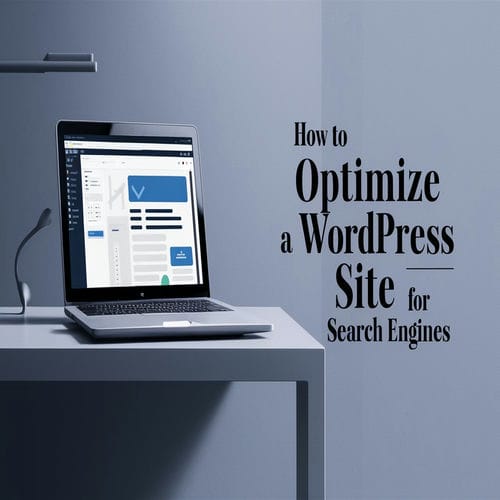Are you looking to boost your website’s visibility and attract more visitors? Optimizing a WordPress site for search engines can seem daunting, but with the right strategies, you can significantly improve your site’s performance.
Imagine your website climbing the search engine rankings, bringing in more traffic and potential customers. Sounds exciting, right? But the question is how to optimize a WordPress site for search engines?
In this guide, we’ll walk you through the essential steps to make your WordPress site more SEO-friendly. There’s always something new to learn in the ever-evolving world of SEO. From choosing the right plugins to mastering keyword research and fine-tuning technical aspects, we’ll cover it all.
So, if you’re ready to take your WordPress site to the next level, let’s dive into the specifics of how to optimize a WordPress site for search engines.
How to Optimize a WordPress Site for Search Engines?
1. Installing Essential Plugins
For effective SEO, it’s crucial to install a robust SEO plugin. Yoast SEO and All in One SEO Pack are two of the most popular options. These plugins offer features such as XML sitemaps, meta tag management, and content analysis to ensure your posts are optimized for your target keywords.
2. Google Analytics Dashboard for WP
Understanding your site’s performance is vital. Google Analytics Dashboard for WP provides detailed insights into visitor behavior directly from your WordPress dashboard. This plugin helps you track page views, bounce rates, and user demographics, enabling data-driven decisions to enhance your SEO strategy.
3. WP Super Cache or W3 Total Cache
Site speed is a critical factor in SEO. Slow loading times can negatively impact user experience and search engine rankings. WP Super Cache and W3 Total Cache improve your site’s speed by generating static HTML files and reducing server load. These plugins are easy to configure and can significantly boost your site’s performance.
4. Smush for Image Optimization
Large images can slow down your website, affecting SEO. Smush is an excellent plugin for image optimization. It compresses images without compromising quality, ensuring faster load times.
With Smush, you can bulk optimize existing images and automatically compress new uploads, keeping your site running smoothly.
By installing these essential plugins, you lay a strong foundation for your WordPress site’s SEO. Each plugin addresses a specific aspect of optimization, making it easier to manage and improve your site’s performance.
Must Read:
Keyword Research and Content Strategy
1. Identifying Target Keywords
Effective SEO starts with identifying the right keywords. Target keywords are the phrases your potential audience is searching for. Use tools like Google Keyword Planner, SEMrush, and Ahrefs to discover relevant keywords with good search volume and low competition. Focusing on these keywords ensures that your content attracts the right visitors.
2. Using Keyword Research Tools
Keyword research tools provide valuable insights into search trends and user behavior. Google Keyword Planner helps you find keyword ideas and understand their search volumes.
SEMrush and Ahrefs offer comprehensive data on keyword difficulty, competition, and related keywords. Utilizing these tools allows you to refine your keyword strategy and create content that ranks well in search results.
3. Developing a Content Calendar
A well-structured content calendar is essential for consistent and strategic content creation. Plan your blog posts and updates around your target keywords.
Ensure a mix of evergreen content and timely posts to keep your audience engaged and improve your site’s SEO. A content calendar helps you maintain regular posting schedules, which is favored by search engines.
4. Creating High-Quality, Engaging Content
Content is the heart of SEO. Create high-quality, engaging content that provides value to your readers. Focus on addressing common questions and solving problems related to your niche.
Use your target keywords naturally within the content, without keyword stuffing. Well-written content encourages longer site visits, shares, and backlinks, all of which boost SEO.
5. Implementing Keywords Naturally in Content
Proper keyword placement is crucial for SEO. Use your primary keyword in the title, first paragraph, headers, and throughout the content. Ensure the flow remains natural and the content readable.
Overusing keywords can lead to penalties from search engines. Instead, aim for a balanced approach that enhances the user experience while optimizing for search engines.
By following these, you can develop a strong keyword strategy and content plan that drives traffic to your WordPress site.

On-Page SEO
1. Optimizing Meta Titles and Descriptions
Meta titles and descriptions are crucial for search engine visibility. Your meta title should be concise, include the primary keyword, and be under 60 characters.
The meta description should be informative and enticing, incorporating the primary keyword and staying within 155-160 characters. Well-crafted meta titles and descriptions improve click-through rates and search engine rankings.
2. Using Header Tags Effectively
Header tags (H1, H2, H3, etc.) structure your content and make it easier to read. The H1 tag should include your main keyword and accurately describe the content. Subheadings (H2, H3) should be used to break up text and incorporate secondary keywords. Proper use of header tags enhances readability and SEO.
3. Writing SEO-Friendly URLs
SEO-friendly URLs are short, descriptive, and include the primary keyword. Avoid using complex numbers or irrelevant words. A clean URL structure not only improves search engine indexing but also makes it easier for users to understand the content of your page.
4. Adding Alt Text to Images
Alt text describes the content of images to search engines. Including relevant keywords in the alt text helps improve your site’s SEO. Ensure every image has an alt attribute that accurately reflects the image content, enhancing accessibility and search engine understanding.
5. Ensuring Proper Use of Internal Linking
Internal links connect your site’s pages and help distribute link equity. Use relevant anchor text to link to other pages on your site. This practice not only improves user navigation but also helps search engines crawl and index your site more effectively.
6. Utilizing Schema Markup
Schema markup provides additional context to search engines about your content. Implementing schema can enhance your search results with rich snippets, such as star ratings or product information. Use tools like Google’s Structured Data Markup Helper to add schema markup to your site.
Technical SEO
1. Improving Site Speed and Performance
Site speed is a critical factor in both user experience and search engine rankings. To improve your WordPress site’s speed, enable caching with plugins like WP Super Cache or W3 Total Cache. Compress images using tools like Smush or ShortPixel.
Minimize CSS and JavaScript files to reduce load times. Regularly monitor your site’s performance with tools like Google PageSpeed Insights or GTmetrix to identify areas for improvement.
2. Mobile Optimization
With the increasing number of mobile users, ensuring your site is mobile-friendly is essential. Use a responsive design that adjusts to various screen sizes. Test your site on different devices to ensure it provides a seamless experience.
Implementing Accelerated Mobile Pages (AMP) can further enhance your site’s performance on mobile devices by delivering faster load times.
3. Ensuring a Secure Website (HTTPS)
Security is a priority for search engines and users alike. Switch your site to HTTPS by obtaining an SSL certificate. Many hosting providers offer free SSL certificates through Let’s Encrypt. HTTPS encrypts data transferred between the user and your site, providing a secure browsing experience. Additionally, search engines favor secure sites, which can improve your rankings.
4. Creating and Submitting XML Sitemaps
XML sitemaps help search engines understand your site’s structure and index it more effectively. Use SEO plugins like Yoast SEO or All in One SEO Pack to generate an XML sitemap automatically.
Submit your sitemap to Google Search Console and Bing Webmaster Tools to ensure your site is indexed properly and to monitor its performance.
5. Setting Up Robots.txt
The robots.txt file guides search engine crawlers on which pages to index and which to ignore. Properly configuring your robots.txt file can improve your site’s SEO by preventing the indexing of duplicate or low-value content. Use tools like Google Search Console to test and validate your robots.txt file.
6. Regularly Checking for Broken Links
Broken links negatively impact user experience and SEO. Regularly check your site for broken links using tools like Broken Link Checker or Screaming Frog. Fix or remove any broken links to ensure smooth navigation and maintain a positive user experience.
Off-Page SEO
1. Building High-Quality Backlinks
Backlinks from reputable sites enhance your site’s authority and search engine rankings. Focus on earning high-quality backlinks through guest posting, collaborating with influencers, and creating shareable content.
Quality over quantity is crucial; a few strong backlinks are more valuable than numerous low-quality ones.
2. Social Media Integration
Integrating your site with social media platforms boosts visibility and engagement. Share your content on social media to drive traffic and encourage sharing. Engage with your audience on these platforms to build relationships and increase your content’s reach.
3. Encouraging User Reviews and Testimonials
Positive reviews and testimonials build trust and improve your site’s reputation. Encourage satisfied customers to leave reviews on platforms like Google My Business, Yelp, and industry-specific sites. Display these testimonials on your site to enhance credibility and attract new visitors.
Monitoring and Analytics
1. Setting Up Google Analytics
Google Analytics is essential for tracking your site’s performance. Install the Google Analytics Dashboard for WP plugin to integrate it with your WordPress site.
This tool provides detailed insights into visitor behavior, page views, bounce rates, and more. Use this data to understand what is working and where improvements are needed.
2. Configuring Google Search Console
Google Search Console helps you monitor your site’s presence in Google search results. Verify your site and submit your XML sitemap. Use Search Console to track search queries, check indexing status, and identify any crawl errors. This information is vital for maintaining and improving your site’s SEO.
3. Regularly Checking Site Performance Metrics
Regularly review key performance metrics to stay informed about your site’s health. Pay attention to metrics such as organic traffic, bounce rate, average session duration, and conversion rates. Tools like SEMrush and Ahrefs can provide additional insights into your site’s performance and competitive position.
4. Using SEO Tools for Ongoing Analysis
SEO tools like SEMrush, Ahrefs, and Moz offer comprehensive data and analysis. Use these tools to conduct keyword research, track rankings, and analyze backlinks. Regular use of these tools helps you stay ahead of SEO trends and make data-driven decisions to enhance your site’s performance.
By consistently monitoring and analyzing your site’s performance, you can make informed adjustments to your SEO strategy.

Advanced SEO Techniques
1. Implementing Structured Data
Structured data markup provides search engines with additional context about your content. Implement schema markup to enhance your search results with rich snippets, such as star ratings or product information. This improves visibility and click-through rates, ultimately driving more organic traffic to your site.
2. Optimizing for Voice Search
Voice search is becoming increasingly prevalent with the rise of smart assistants. Optimize your content for voice search by focusing on long-tail keywords and natural language.
Provide concise, informative answers to common questions your audience may ask. By tailoring your content to voice search queries, you can capture valuable traffic from this growing segment of users.
3. Utilizing Content Delivery Networks (CDNs)
Content Delivery Networks (CDNs) improve site performance by distributing content across multiple servers worldwide. This minimizes the delay and ensures faster load times for users across different geographic locations. Implementing a CDN can significantly enhance user experience and SEO, especially for sites with global audiences.
4. Conducting Regular SEO Audits
Regular SEO audits are essential for identifying areas of improvement and maintaining your site’s performance. Use tools like Screaming Frog or Sitebulb to audit your site’s technical SEO, on-page optimization, and backlink profile. Address any issues promptly to ensure your site remains competitive in search rankings.
By incorporating these advanced SEO techniques into your strategy, you can further optimize your WordPress site for search engines and stay ahead of the competition.
Conclusion
Optimizing a WordPress site for search engines is a continuous process that requires attention to detail and a commitment to excellence. By implementing the strategies outlined in this guide, you can improve your site’s visibility, attract more organic traffic, and achieve your business goals.
Remember, SEO is not a one-time task but an ongoing effort to stay ahead in the competitive online landscape. Ready to take your WordPress site to the next level?
Visit Devtrain.co to explore our comprehensive SEO services and start optimizing your site today!




binance
Your article helped me a lot, is there any more related content? Thanks!
binance us register
Thanks for sharing. I read many of your blog posts, cool, your blog is very good.